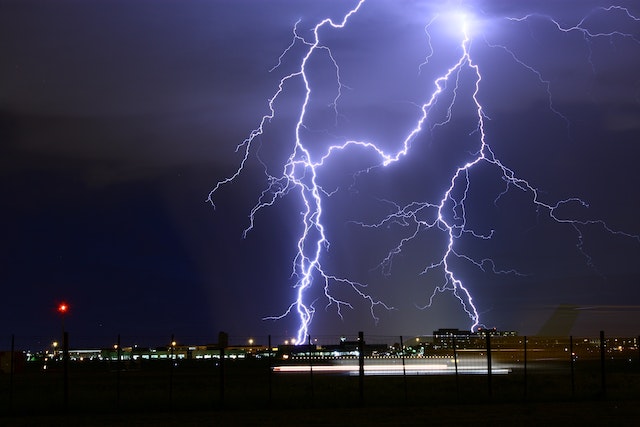
What causes thunder? Thunder is caused because the air around a lightning bolt is superheated.
Lightning is caused when there is an imbalance in the electrical charge within clouds. During a heavy storm, strong winds circulate through storm clouds. The wind picks up water droplets at the bottom and carries them to the top of the cloud, where they freeze in the very cold temperature. The heavier ice is then pushed back down by the wind. As the wind pushes the ice down it hits the water droplets coming up and the water droplets pull electrons off the ice. The charged water carries the positive charge to the top of the clouds and leaves a negative charge at the bottom of the cloud.
The atmosphere acts as an insulator, keeping the charges away from the ground. The positive charge at the top of the cloud and the negative charge at the bottom have to balance themselves out. Most of the time they will do it within the cloud, which is why most lightning is inside the cloud.
However, if the cloud is low enough, the negative charge at the bottom of the cloud will attract the positive charge in the ground. The positive charges move up into the tall objects, trying to get as close to the cloud as they can. Lightning mostly comes from cumulonimbus clouds because they have low bases, 1km, and high tops, 15km. The negative charge coming out of the bottom of a cloud is called a “step leader”. The charge in the cloud slowly ionizes the air below the cloud by stripping electrons from the air molecules. These step leaders move closer and closer to the ground in steps. At the same time, the electric field that the step leaders creates begins to attract the positive charge from the ground and streamers of positive charge rise up into the sky.
When the highest positively charged streamer from the ground and the lowest negatively charged step leader from the cloud touch, they complete the circuit and this is when we see the lightning bolt.
So, where does the thunder come from? The lightning bolt has so much energy that it heats the air to over 30,000℃ in milliseconds. When the air heats it expands, compressing the air around it. The heated air expands, but as it expands, the pressure drops, lowering the temperature. The air contracts again. That expansion and contraction causes a shockwave, which is what we hear as thunder. We hear the thunder as a rolling sound because of the way the sound reaches us. The lightning bolt goes from the ground to the clouds, and we hear the sound from the bottom of the bolt first followed successively by the sound from higher and higher up the lightning bolt. If there is more than one lightning bolt, the sounds will bounce of each other making an even larger rolling sound.
You probably already know this, but you can use thunder to judge the distance of a storm. You will see the flash of lightning instantly because it travels at the speed of light. Start counting the seconds until you hear the thunder. You know that the thunder travels to you at the speed of sound (343m/s), so if you multiply the number of seconds by the speed of sound, you can calculate how far away the storm is.
Because of the way that lightning forms, the best way to avoid being struck by lightning is often just to not be the tallest object in the vicinity, or near to the tallest object. You definitely don’t want to stand under a tree because a ground charge will spread out from the base of the tree. Being under a tree is the second leading cause of lightning casualties. If you can, you want to be in a car or a house with lots of pipes and wiring in the walls. This will help you because the frame of the car and the metal in the walls of the house will conduct the electricity around you rather than through you.
If you do happen to be struck by lightning, it appears that the majority of people do survive, but not always in one piece. Between 1989 and 2018, 43 people per year were killed by lightning in the United States. However, only 10% of the people who are struck die.
So, what causes thunder? Air rapidly heated by lightning compresses and contracts, causing thunder. And this is what I learned today.
Sources
http://lightningsafety.com/nlsi_info/thunder2.html
https://en.wikipedia.org/wiki/Thunder
https://en.wikipedia.org/wiki/Lightning
